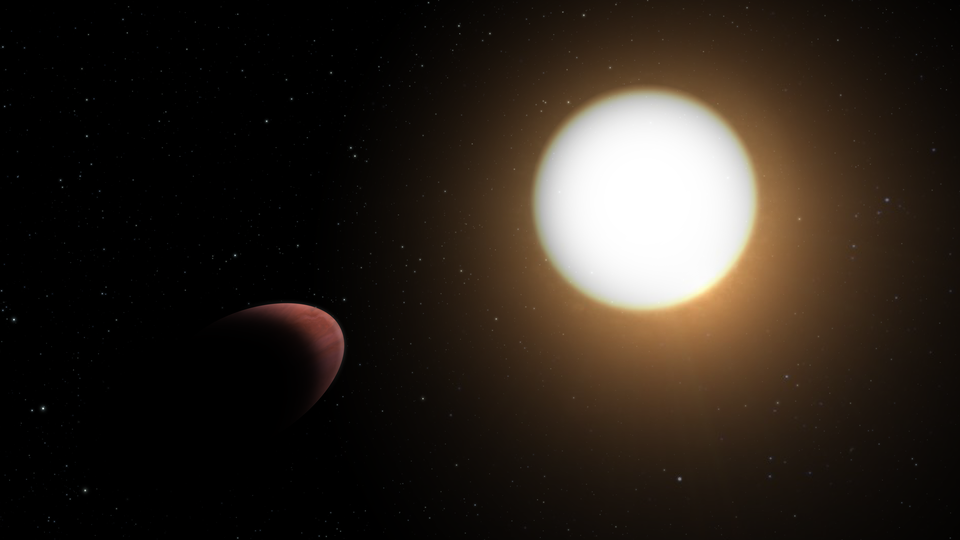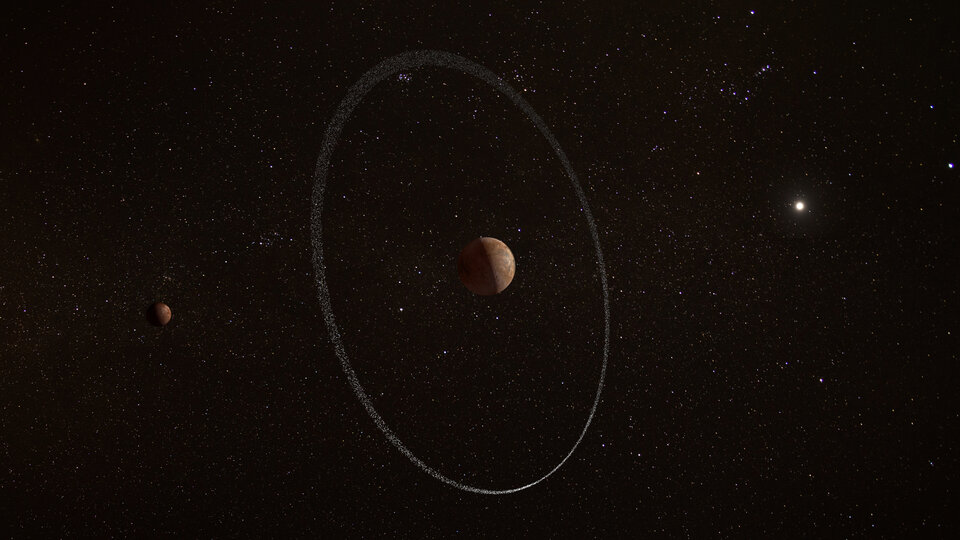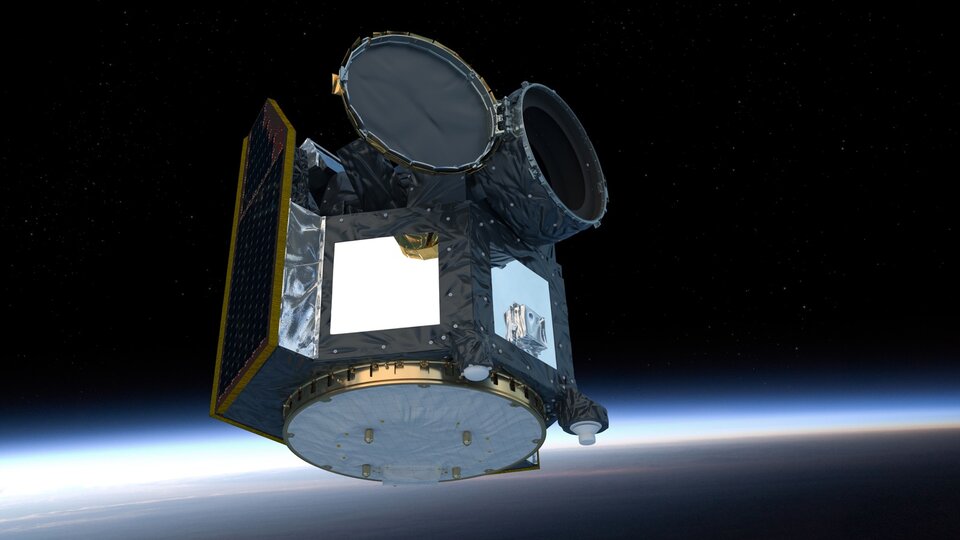Exoplanets all over the universe come in different sizes, compositions, colors, and temperatures. However, they typically don’t come in different shapes, as nearly every single planet ever discovered is thought to be spherical in shape — except for one.
New data from the European Space Agency’s (ESA) Characterising Exoplanets Satellite (CHEOPS) space observatory, as well as data collected by the NASA/ESA Hubble Space Telescope and NASA’s Spitzer Space Telescope, has revealed the shape of an exoplanet that features many extreme characteristics. The CHEOPS data is the first time astrophysicists have ever detected the deformation of an exoplanet and provides valuable information into the internal structure of exoplanets.
WASP-103b
The planet in question is WASP-103b, a super-Jupiter exoplanet located in the constellation Hercules. WASP-103b orbits the star WASP-103, an F-type main-sequence star that is located 1,800 ± 100 light-years away from our solar system. WASP-103 is about 1.7 times larger than our Sun and is around 200 degrees hotter.
WASP-103b has many unique features. Discovered in 2014, it is approximately twice the size and 1.5 times the mass of Jupiter, features an atmosphere that contains water, and orbits its star in less than a day. The exoplanet was discovered via the transit method, wherein a star is observed as an exoplanet transits it — allowing scientists to calculate the contents of a planet’s atmosphere (if it has one) and its size.

ESA infographic providing information on WASP-103b and WASP-103. (Credit: ESA)
The extremely short orbital period of WASP-103b is the main cause of the planet’s odd shape. The reason for WASP-103b’s short orbital period is the distance at which it orbits WASP-103 — with the exoplanet’s semi-major axis being an astonishing 0.01987 astronomical units (AU) — one AU being the approximate average distance between the Sun and the Earth. The smaller the orbit of a planet, the faster it will orbit its host star.
Like Earth, WASP-103b experiences tidal tugging from its host star. However, WASP-103b’s extremely tight orbit allows WASP-103 to exert a much stronger tidal force on the planet. This powerful tidal tug is what caused the deformation of WASP-103b.
Astrophysicists and astronomers who have studied the WASP-103 system had for many years theorized that WASP-103b’s star-hugging orbit would cause tidal deformation of the planet’s crust. However, they hadn’t been able to efficiently measure the exact amount of tidal force exerted on the exoplanet until CHEOPS’ capabilities allowed them to do so.
But how?
CHEOPS is able to measure the specific properties of exoplanets by measuring the transits of exoplanets in front of the stars they orbit. As aforementioned, the transit method involved observing a star as an exoplanet crosses in front of it. When this occurs, the amount of light that is emitted by a star will dip and create a light curve, allowing scientists to measure characteristics including the shape, size, and atmospheric contents of the planet.
Most telescopes are able to observe the transiting of an exoplanet; however, CHEOPS’ advanced precision and flexibility allow it to observe very small changes in the light curve produced by an exoplanet transit event. This is precision is what allowed CHEOPS to observe the deformation in WASP-103b’s shape.
“It’s incredible that Cheops was actually able to reveal this tiny deformation,” says Jacques Laskar of Paris Observatory, Université Paris Sciences et Lettres, and co-author of the research. “This is the first time such analysis has been made, and we can hope that observing over a longer time interval will strengthen this observation and lead to better knowledge of the planet’s internal structure.”

An example of a light curve generated from an exoplanet transiting its star. (Credit: NASA Ames)
Using the light curve CHEOPS produced from WASP-103b’s transit of WASP-103, researchers were able to derive a value known as the Love number. The Love number measures the amount of mass and how mass is distributed within a planet. Having the Love number provides insight into the internal structure of a planet.
The Love number derived for WASP-103b is similar to the Love number of Jupiter — hinting towards WASP-103b having a similar internal structure to Jupiter’s, even though WASP-103b is around twice the radius of Jupiter.
“The resistance of a material to being deformed depends on its composition,” explains the study’s lead author, Susana Barros of Portugal’s Instituto de Astrofísica e Ciências do Espaço and the University of Porto.
“For example, here on Earth we have tides due to the Moon and the Sun but we can only see tides in the oceans. The rocky part doesn’t move that much. By measuring how much the planet is deformed we can tell how much of it is rocky, gaseous, or water.”
“In principle, we would expect a planet with 1.5 times the mass of the Jupiter to be roughly the same size, so WASP-103b must be very inflated due to heating from its star and maybe other mechanisms,” said Barros.
Although the derived Love number provides some insight into the inner workings of WASP-103b, it is quite high, and there is still some uncertainty in the viability of the number. The recently launched James Webb Space Telescope will work together with CHEOPS in the future to continue measuring the tidal deformation of WASP-103b and other exoplanets like it.
“If we can confirm the details of its internal structure with future observations maybe we could better understand what makes it so inflated. Knowing the size of the core of this exoplanet will also be important to better understand how it formed,” Barros explained.
On top of the strange deformation of WASP-103b, it also exhibits weird orbital properties with its star.
Typically, when a planet as large as WASP-103b orbits extremely close to a star like WASP-103, the tidal interactions between the two bodies would gradually pull the planet’s orbit closer to the star, until the planet is eventually engulfed by the star.
However, the exact opposite is happening with WASP-103b.
The measurements taken by CHEOPS of WASP-103b seem to show that the exoplanet is slowly drifting away from its parent star and that its orbital period is increasing. This would suggest that there must be a force stronger than that of WASP-103’s tidal force pulling the exoplanet away from the star.
Barros and her fellow researchers investigated several different scenarios that tried to tackle the question of what exactly is pulling WASP-103b away from its star. One of these scenarios involved a companion star to WASP-103 that would cause the effects the team saw in the data, while another scenario investigated whether or not an elliptical orbit could be causing the effects that the scientists observed.
The team of researchers was unable to verify if any of the scenarios were correct, but they aren’t ruling them out. In fact, the orbit of WASP-103b could not be increasing at all and actually be decreasing. However, to confirm this, further observations and transits of WASP-103b are needed.
CHEOPS
CHEOPS (CHaracterising ExOPlanets Satellite) launched on December 18, 2019, atop a Soyuz ST-A rocket, flight number VS23, from Kourou, French Guiana. The observatory is operated by the European Space Agency (ESA) in an approximately-700-kilometer sun-synchronous polar orbit.
The primary goal of CHEOPS is to measure the size of exoplanets orbiting stars throughout the universe. Being able to determine the size of an exoplanet allows teams to then estimate its mass, density, composition, formation, and other characteristics. Additionally, CHEOPS is the first mission dedicated to studying exoplanets surrounding nearby stars that have previously been confirmed to have exoplanets. This allows CHEOPS to build off of previous research and data.
CHEOPS is able to perform these measurements by observing the transits of exoplanets in front of their respective stars, allowing the observatory to create light curves which showcase the characteristics of the exoplanets it is studying. CHEOPS primarily targets exoplanets in the super-Earth to Neptune size range.
“The size of the effect of tidal deformation on an exoplanet transit light curve is very small, but thanks to the very high precision of CHEOPS we are able to see this for the first time,” said Kate Isaak, ESA Project Scientist for CHEOPS.
“This study is an excellent example of the very diverse questions that exoplanet scientists are able to tackle with CHEOPS, illustrating the importance of this flexible follow-up mission,” said Issak.
As of January 2021, CHEOPS is a little over two years into its mission, which is expected to last three and a half years.
(Lead image: Artist’s depiction of rugby-ball shaped WASP-103b orbiting WASP-103. Credit: ESA)
Quelle: NS
----
Update: 30.01.2022
.
Extreme exoplanet has a complex and exotic atmosphere

WASP-189b is a planet outside our own solar system, located 322 light years from Earth. Extensive observations with the CHEOPS space telescope in 2020 revealed among other things that the planet is 20 times closer to its host star than Earth is to the Sun and has a daytime temperature of 3200 degrees Celsius. More recent investigations with the HARPS spectrograph at the La Silla Observatory in Chile now for the first time allowed the researchers to take a closer look at the atmosphere of this Jupiter-like planet.
An international team including researchers from the University of Bern and the University of Geneva as well as the National Centre of Competence in Research (NCCR) PlanetS analyzed the atmosphere of one of the most extreme known planets in great detail. The results from this hot, Jupiter-like planet that was first characterized with the help of the CHEOPS space telescope, may help astronomers understand the complexities of many other exoplanets - including Earth-like planets.
The atmosphere of Earth is not a uniform envelope but consists of distinct layers that each have characteristic properties. The lowest layer that spans from sea level beyond the highest mountain peaks, for example - the troposphere -, contains most of the water vapour and is thus the layer in which most weather phenomena occur. The layer above it - the stratosphere - is the one that contains the famous ozone layer that shields us from the Sun's harmful ultraviolet radiation.
In a new study that appeared in the journal Nature Astronomy, an international team of researchers led by the University of Lund show for the first time that the atmosphere of one of the most extreme known planets may have similarly distinct layers as well - albeit with very different characteristics.
An exotic cocktail for an atmosphere
WASP-189b is a planet outside our own solar system, located 322 light years from Earth. Extensive observations with the CHEOPS space telescope in 2020 revealed among other things that the planet is 20 times closer to its host star than Earth is to the Sun and has a daytime temperature of 3200 degrees Celsius. More recent investigations with the HARPS spectrograph at the La Silla Observatory in Chile now for the first time allowed the researchers to take a closer look at the atmosphere of this Jupiter-like planet.
"We measured the light coming from the planet's host star and passing through the planet's atmosphere. The gases in its atmosphere absorb some of the starlight, similar to Ozone absorbing some of the sunlight in Earth's atmosphere, and thereby leave their characteristic 'fingerprint'. With the help of HARPS, we were able to identify the corresponding substances", lead author of the study and doctoral student at Lund University, Bibiana Prinoth, explains.
According to the researchers, the gases that left their fingerprints in the atmosphere of WASP-189b included iron, chromium, vanadium, magnesium and manganese.
An "Ozone layer" on a blisteringly hot planet?
One particularly interesting substance the team found is a gas containing titanium: titanium oxide. While titanium oxide is very scarce on Earth, it could play an important role in the atmosphere of WASP-189b - similar to that of ozone in Earth's atmosphere.
"Titanium oxide absorbs short wave radiation, such as ultraviolet radiation. Its detection could therefore indicate a layer in the atmosphere of WASP-189b that interacts with the stellar irradiation similarly to how the Ozone layer does on Earth", study co-author Kevin Heng, a professor of astrophysics at the University of Bern and a member of the NCCR PlanetS, explains.
Indeed, the researchers found hints of such a layer and other layers on the ultra-hot Jupiter-like planet. "In our analysis, we saw that the 'fingerprints' of the different gases were slightly altered compared to our expectation. We believe that strong winds and other processes could generate these alterations. And because the fingerprints of different gases were altered in different ways, we think that this indicates that they exist in different layers - similarly to how the fingerprints of water vapour and ozone on Earth would appear differently altered from a distance, because they mostly occur in different atmospheric layers", Prinoth explains. These results may change how astronomers investigate exoplanets.
A different way to look at exoplanets
"In the past, astronomers often assumed that the atmospheres of exoplanets exist as a uniform layer and try to understand it as such. But our results demonstrate that even the atmospheres of intensely irradiated giant gas planets have complex three-dimensional structures", study co-author and associate senior lecturer at Lund University Jens Hoeijmakers points out.
"We are convinced that to be able to fully understand these and other types of planets - including ones more similar to Earth, we need to appreciate the three-dimensional nature of their atmospheres. This requires innovations in data analysis techniques, computer modelling and fundamental atmospheric theory", Kevin Heng concludes.
Quelle: SD
----
Update: 13.09.2022
.
A thousand days of CHEOPS

After a thousand days in orbit, the CHEOPS space telescope shows almost no signs of wear. Under these conditions, it could continue to reveal details of some of the most fascinating exoplanets for quite some time. CHEOPS is a joint mission by the European Space Agency (ESA) and Switzerland, under the aegis of the University of Bern in collaboration with the University of Geneva.
Since its launch from Europe's Spaceport in French Guiana, on December 18th, 2019, the CHEOPS telescope in Earth's orbit has demonstrated its functionality and precision beyond expectations. During this time, it has revealed the characteristics of numerous fascinating planets beyond our Solar System (exoplanets) and has become a key instrument for astronomers in Europe and worldwide.
Enabling plentiful research across Europe
In over a million of minutes of observation time, CHEOPS has revealed exoplanets from every angle: their night sides when they pass in front of their stars, their dayside when they pass behind their stars and all the phases in-between, just like the Moon.
"The precise data we collected from CHEOPS has borne fruits: over fifty scientific papers have been published or are in the process of being submitted by over a hundred scientists forming the CHEOPS Science Team and working at dozens of institutions all over Europe", Willy Benz, Professor emeritus of astrophysics at the University of Bern and head of the CHEOPS consortium, reports.
This has been achieved without the possibility for international scientific team exploiting the instrument to meet physically due to the pandemic. Now, for the first time since the launch of CHEOPS, all involved scientists can finally meet in Padua, Italy, from 12 to 14 September.
"It is the first time in three years that we can finally get together", mission scientist David Ehrenreich and Professor of astronomy at the University of Geneva says. "It feels amazing to celebrate what we have discovered in 1000 days and discuss what we will do next."
Findings include, for example, the characterization of blisteringly hot, iron-evaporating atmospheres on planets that are so close to their stars that they are deformed into rugby-ball shapes by the immense gravitational forces. "By detecting a system with six planets, of which five orbit their star in a fragile harmony, CHEOPS has also given us glimpses into the formation of planetary systems", Ehrenreich says.
Just earlier this year, the space telescope once again demonstrated its astounding precision by measuring the faint light reflected by a planet located 159 light years away in the constellation Pegasus.
"Although this planet, HD 209458b, is certainly the most studied exoplanet ever, we had to wait 22 years for CHEOPS and its amazing precision and dedication to be able to measure the visible light reflected from its atmosphere" Benz says proudly.
A valuable and durable asset
"Even after 1000 days in orbit, CHEOPS still works like a charm and only shows very small signs of wear, caused by energetic particles emitted by the Sun", CHEOPS instrument scientist Andrea Fortier from the University of Bern says. Under these conditions, the researcher expects that CHEOPS could continue to observe other worlds for quite some time.
"It will continue its mission around the Earth until at least September 2023 but the CHEOPS team is working with the European Space Agency and the Swiss Space Office to extend the mission until the end of 2025 and possibly even beyond", Fortier says.
The capabilities of CHEOPS could continue to serve the scientific community well, even now that the James Webb Space Telescope is in operation.
"We are convinced with its high precision and flexibility, CHEOPS can act as a bridge between other instruments and Webb, as the powerful telescope needs precise information on potentially interesting observation targets. CHEOPS can deliver this information - and thus optimize the operation of Webb", Willy Benz points out.
This is already happening, as the Webb telescope will observe, later this year, several systems highlighted by CHEOPS.







